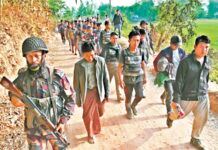
The five-day Durga Puja, the biggest religious festival of the Hindu community, ended on Monday with the immersion of the goddess Durga in the capital and elsewhere across the country.
In the morning, devotees celebrated Bijoya Dashami, the last day of the festival, at some 28,000 Puja mandaps, including 212 in the capital.
Devotees in their tearful eyes bade farewell to the mother deity and her children — Lakshmi, Saraswati, Kartik and Ganesh — through the immersion of their idols in the water wishing Durga’s return next year.
In the capital, streets leading to Sadarghat were filled with thousands of people thronging the Buriganga to observe the final phase of the festival.
The main procession was taken out from the capital’s Dhakeshwari Temple.
Idols from different puja mandaps of the city were gathered at the Polashi Mor. The rally paraded different parts of the old Dhaka before converging at the banks of the Buriganga River for the day’s main ritual.
As the processions marched towards the river, people were seen dancing with the beat of drums [dhak] circling the idols.
The government took tight security measures assigning members of different law enforcement agencies to escort the processions. A huge number of law enforcers, including members of Rapid Action Battalion, stood guard at the mandaps and immersion points.
Bijoya Dashami is the special ceremony of reaffirming peace and good relations among people. Families visited each other to share sweetmeats during the Dashami festivity.
Durga Puja, the annual Hindu festival also known as Sharadiya (autumnal) Durga Utsav, is the worship of ‘Shakti’ [divine force] embodied in goddess Durga.
It symbolises the battle between good and evil where the dark forces eventually succumb to the divine.
The day was a public holiday. President Abdul Hamid hosted a reception to the members of Hindu community on the occasion of Durga Puja.
The state-run and private television channels and radios aired special programmes while newspapers published special supplements on the religious festival.
Source: UNB Connect









